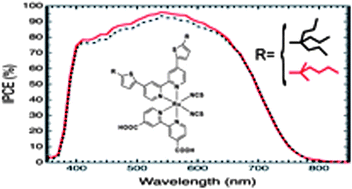Two novel heteroleptic ruthenium sensitizers, TT204 and TT205, containing bulky substituents at the 4,4-positions of the ancillary 2,2-bipyridine ligand, were synthesized and characterized. They exhibit absorption maxima in the visible region at 520-530 nm due to metal-to-ligand charge transfer (MLCT) transitions. The EHOMO and ELUMO values indicate sufficient driving force for efficient dye regeneration by the iodide/tri-iodide redox electrolyte and efficient electron injection into the TiO2 conduction band following photoexcitation, respectively. The performance of these heteroleptic sensitizers in dye sensitized solar cells was investigated where TiO2 sensitization was carried out both in the presence and absence of chenodeoxycholic acid. The best efficiency among these sensitizers was recorded in the presence of chenodeoxycholic acid which generated a high short circuit current of 18.7 mA cm-2, an open circuit potential of 0.72 V and a fill factor of 73% with a resulting total power conversion efficiency of 9.81% under AM 1.5G 1 sun illumination. Comparison with the reference dye C101 indicates that though bulky groups can prevent aggregation resulting in high photocurrents even in the absence of chenodeoxycholic acid, they can also lead to lower cell voltages due to inefficient dye packing on the TiO2 surface.
